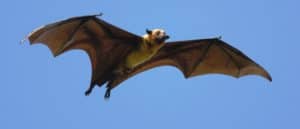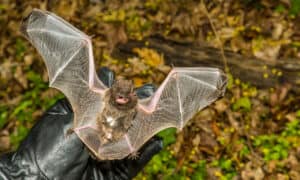Bats are incredible creatures, and there’s no denying that. They are stellar mothers who fly around with their little pups attached to them while they hunt. Bats also do a fantastic job of eating vast quantities of flying insects during their nighttime excursions. They can eat 6,000 – 8,000 insects like mosquitos per night! Whether you’re in the bat fan club or not, they eliminate millions of flying insects EACH every year! That’s a lot of work. They raise families when they aren’t busy eating half their body weight nightly in insects. What are some of the mating habits of bats? Do they mate for life or sleep around a bit?
What is a Bat?
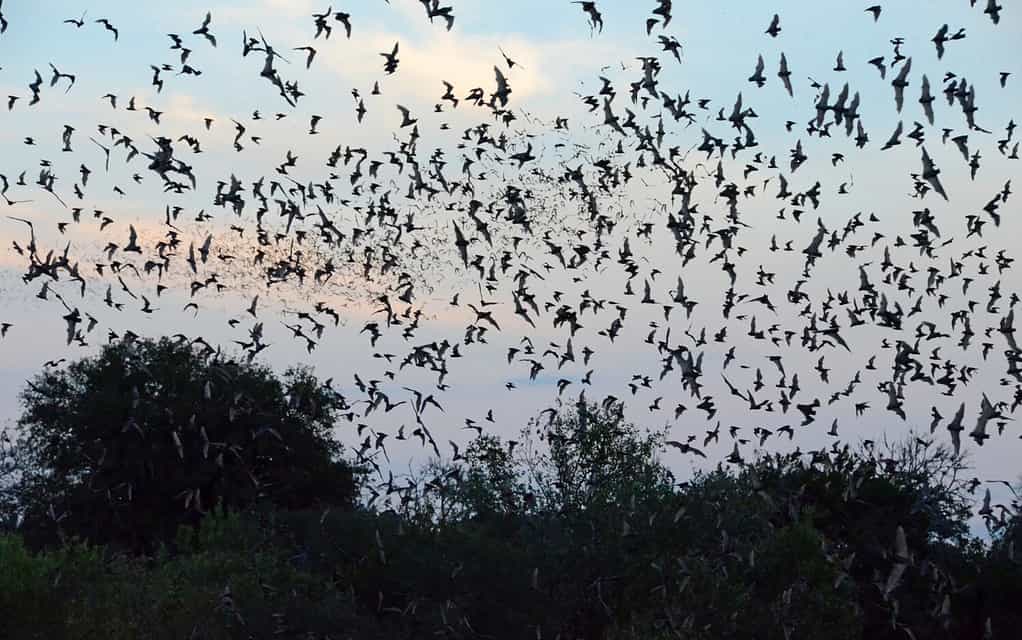
Mexican Free-tailed bats emerge from a cave to hunt for insects.
©Jeff Reeves/Shutterstock.com
Many types of bats range from as small as a bumble bee, like Kitti’s hog-nosed bat, to the largest bat, the giant golden-crowned flying fox. Some bats chow down on fruit and nectar, whereas others eat insects. A few even eat small prey or fish, while a few others drink blood, and no, they are not hunting you.
Bats are the only mammals capable of flight, with over 1,200 known species. They are generally highly social and roost together in high numbers in caves. The bats can roost in hundreds or thousands of clusters against one another. They do this to share body heat and make the cave cozier. Other bats roost in open areas like mountain faces, trees, bat boxes, or artificial structures like abandoned houses or attics. This gives “bats in the belfry” a genuine meaning.
Thank Your Local and National Bats Today!
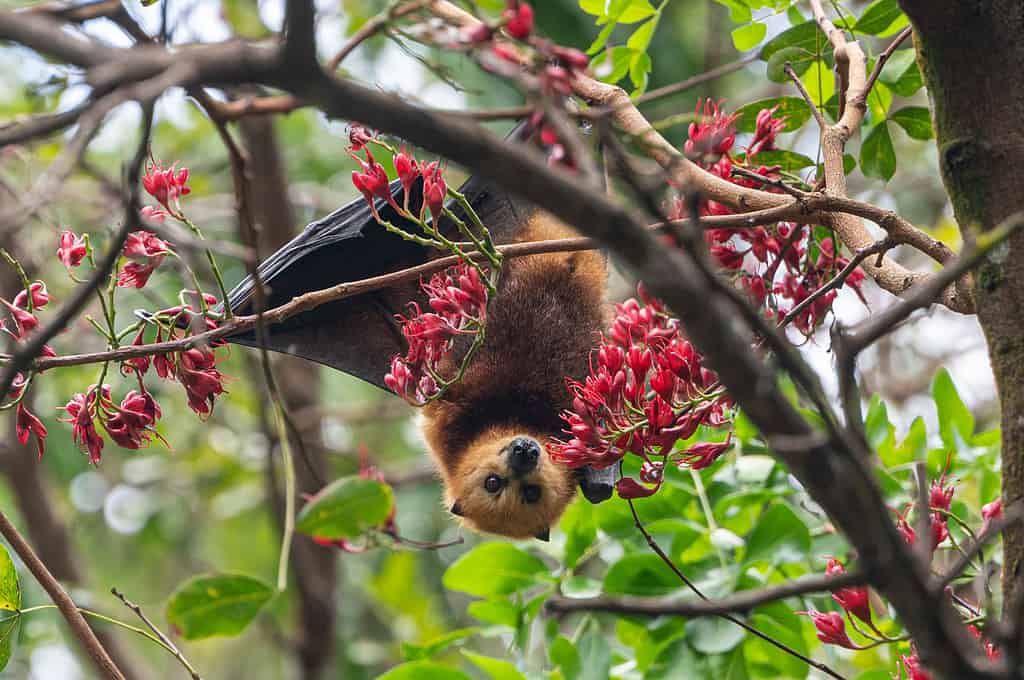
Flying foxes, sometimes known as fruit bats, are responsible for planting hundreds or thousands of trees yearly.
©Andi Edwards/iStock via Getty Images
Fruit or flying fox bats have been known to gather in some trees in many thousands and are damaging to the tree since they strip it of foliage, which is okay since they are responsible for planting many more. Flying foxes are accountable for rebuilding struggling forests in Africa. Out of 150,000 flying foxes, they could deposit over 300,000 seeds in one evening. That is enough to grow trees on 800 hectares of forest!
If humans would step back for a while, think of the fantastic difference bats would be able to make all over the world, but especially in areas where the rainforests have been tampered with by greedy humans. Bats could save the world, so be sure to tell the bat haters in your life about the amazingly great jobs they do at protecting the world and, mostly, the human population from being eradicated by diseases carrying mosquitos and planting more trees and plants than we could ever do alone. They take so much fruit from fig trees that farmers must put up nets to harvest any. It makes one wonder if a fruit bat has tried a Fig Newton cookie.
Problems with Bats
Sadly, bats are not without flaws, just like everyone else. They are susceptible to rabies and are among the most common carriers, along with raccoons, foxes, and coyotes. Many people are terrified by them because of that. It is not expected to find any rabid animal, though caution should always be used around any wildlife.
They sometimes also carry the deadly white-nose syndrome that can spread among bats and wipe out entire colonies during hibernation. It is caused by the fungus Pseudogymnoascus destructans. It has killed millions of bats in the last two decades and commonly affects the little brown bat. The fungus is native to Europe and China, where the bats have become immune to it. Bats in the U.S. are not able to survive it.
Do Bats Mate For Life?
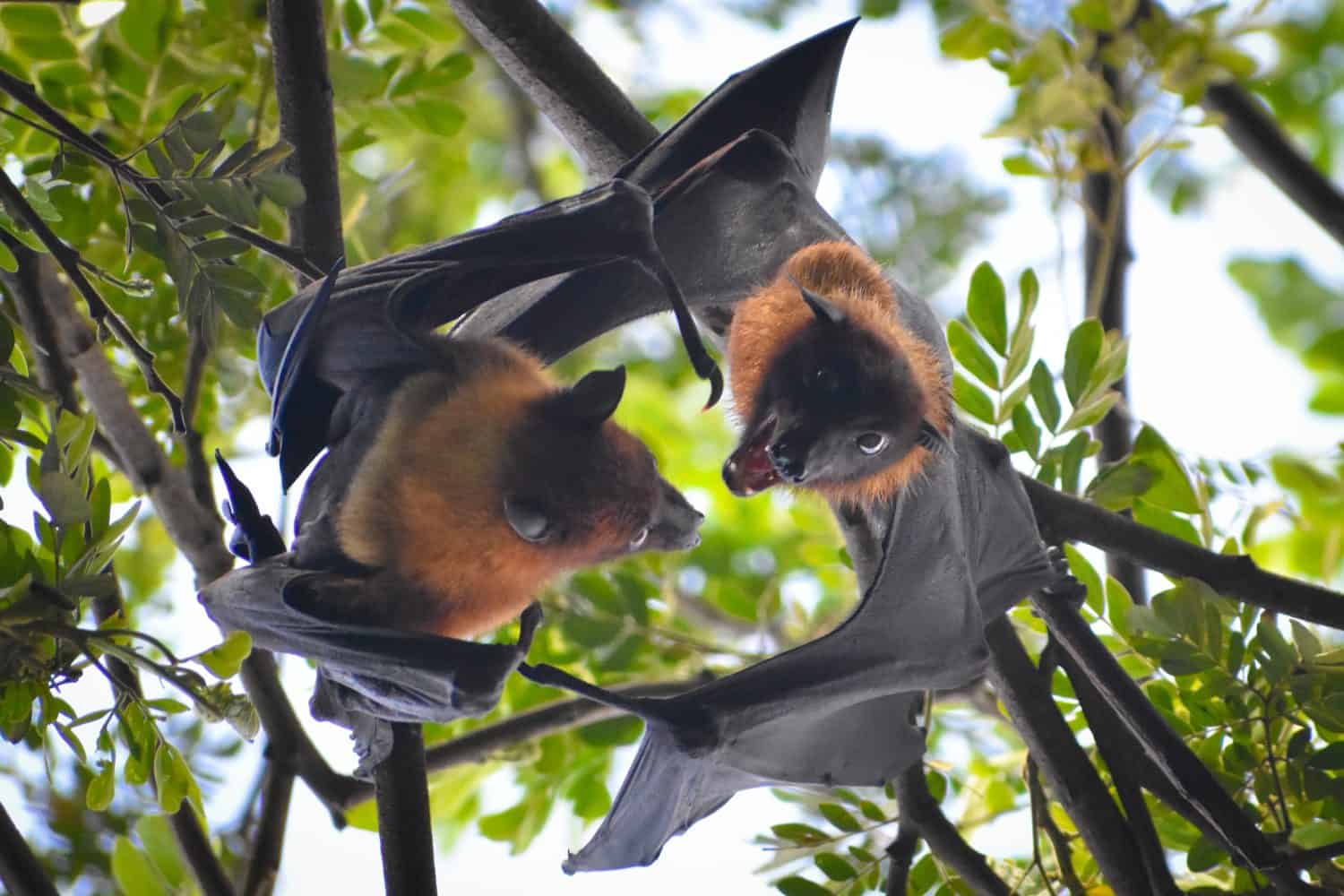
Sometimes, the mating habits of bats can seem a bit scandalous.
©ELAMARAN ELAA PHOTOGRAPHY/Shutterstock.com
Spectral bats, African yellow-winged bats, lesser white-lined bats, painted wooly bats, and others are monogamous. It isn’t easy to understand if their coupling means a season or a lifetime.
Spectral bats (Vampyrum spectrum) have a rather endearing partnership. The male and female form a lifelong bond and always stay together. Both parents bring food back to the roost to feed their pup. The male bat has been documented wrapping his wings in a loving embrace around the female bat and their pup. These bats share their food and are sometimes called false vampire bats.
The African yellow-winged bat (Lavia frons) is a monogamous bat with a cute partner-selecting ritual. The two bats take turns flying over each other and then flying in circles around each other before deciding to spend their batty lives as a unit. Both parents take care of their pup and roost near each other. The male takes on the job as the protector of their small family while the female grooms the pup. The male and female groom each other.
Some other types of bats are monogamous, but it is unknown if it is for one mating season or a lifetime. Most bats have separate areas where they roost. Once pregnant, females sometimes move in and roost with other pregnant bats in a maternity ward near the rest of the colony. Once their pups are born, it becomes a nursery where they will all take part in raising their pups together.
Bat Mating Season
In the spring, when most wildlife are out looking for love in warmer temperatures, bats do the same. Most bats north of the equator only give birth to one pup yearly. This happens in the warm summer months when there are plenty of insects to eat. Bats may reproduce more frequently closer to the equator since the temperatures are more generous.
When bats seek partners, the males give off scents to attract females. The males also make sounds to let the females know he’s looking for love. Some male bats will even wake a female bat for the evening hunt by giving her a nip on the neck and hoping to get lucky. In other species, the male bats might sit back and relax while their sexy bat pheromones do the trick of drawing in the females. They are not overachievers.
Male bats will take to the skies in significant numbers in some species while putting on a breathtaking flying extravaganza. They show off their best moves, such as soaring, diving, cutting close corners, and performing their most fantastic stunts. This is to show their agility, which gets the attention of female bats. After their show wraps up, the paired bats find a secluded area to mate. They do their best to appeal to all senses during their courting performance.
Bats Can Be Polygamous or Promiscuous
Most bats are polygamous, with the males taking on a most likely promiscuous nature in their mating. Indeed, some of the female bats want to share baby daddies with some of the other mother bats. After all, their pups can grow up together as stepbats.
Fruit bats are known to be promiscuous. The males have harems of females that all stay together mating. It is the same for the African banana leaf bat. Some of the species of fruit bats have proven to also engage in oral sex! Fruit bats or flying foxes also all mate around the same time, so within one tree holding hundreds of these bats, they could almost all be mating simultaneously. That is one major bat orgy!
The promiscuous or polygamous males do not take part in parenting their offspring. Not that it should come as a surprise!
Common Mating Habits

©J.J.Rico/Shutterstock.com
- Male bats all do something to either impress or attract females to them. It could be pheromones, sounds, or acrobatics while flying. Some male bats do a combination of all of the above.
- Almost all male bats are polygamous and promiscuous. They will impregnate as many females as they can in the mating season.
- Some male bats will hold food in their mouths, hoping a female will find them attractive enough with the snack to want to mate.
- A handful of species of male bats bite their partners as a form of courtship or foreplay.
- Fruit bats or flying foxes have been documented engaging in oral sex with multiple partners.
- Many species of bats will mate at the same time in the same area, much like a giant bat orgy.
- Many female bats will roost together in a separate section from where the colony is roosting to form a maternity ward.
- Very few species of bats stay together for life. Those who also parent, care for each other, and often closely bond and fly together at night.
- Male bats are commonly protective of female bats and pups, even if they are not mates or kin.
- Almost all bats mate in the spring and give birth to one pup in the summer. The only ones that do not embrace this are the bats, who live very close to the equator, where it stays warm enough for insects to be abundant year-round.
The photo featured at the top of this post is © Sarun T/Shutterstock.com
Thank you for reading! Have some feedback for us? Contact the AZ Animals editorial team.



